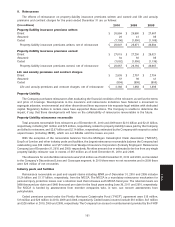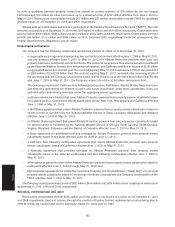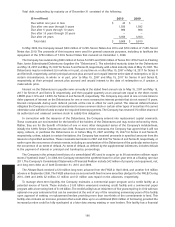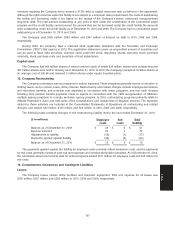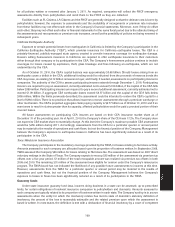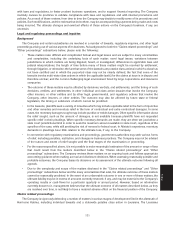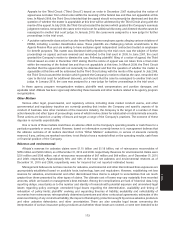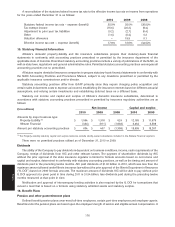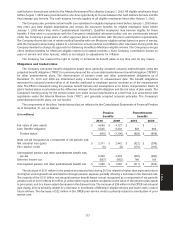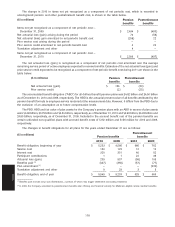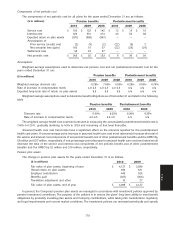Allstate 2011 Annual Report Download - page 249
Download and view the complete annual report
Please find page 249 of the 2011 Allstate annual report below. You can navigate through the pages in the report by either clicking on the pages listed below, or by using the keyword search tool below to find specific information within the annual report.
for all policies written or renewed after January 1, 2011. As required, companies will collect the FHCF emergency
assessments directly from policyholders and remit them to the FHCF as they are collected.
Facilities such as FL Citizens, LA Citizens and the FHCF are generally designed so that the ultimate cost is borne by
policyholders; however, the exposure to assessments and the availability of recoupments or premium rate increases
from these facilities may not offset each other in the Company’s financial statements. Moreover, even if they do offset
each other, they may not offset each other in financial statements for the same fiscal period due to the ultimate timing of
the assessments and recoupments or premium rate increases, as well as the possibility of policies not being renewed in
subsequent years.
California Earthquake Authority
Exposure to certain potential losses from earthquakes in California is limited by the Company’s participation in the
California Earthquake Authority (‘‘CEA’’), which provides insurance for California earthquake losses. The CEA is a
privately-financed, publicly-managed state agency created to provide insurance coverage for earthquake damage.
Insurers selling homeowners insurance in California are required to offer earthquake insurance to their customers
either through their company or by participation in the CEA. The Company’s homeowners policies continue to include
coverages for losses caused by explosions, theft, glass breakage and fires following an earthquake, which are not
underwritten by the CEA.
As of October 31, 2010, the CEA’s capital balance was approximately $3.68 billion. Should losses arising from an
earthquake cause a deficit in the CEA, additional funding would be obtained from the proceeds of revenue bonds the
CEA may issue, an existing $3.12 billion reinsurance layer, and finally, if needed, assessments on participating insurance
companies. The authority of the CEA to assess participating insurers extends through December 1, 2018. Participating
insurers are required to pay an assessment, currently estimated not to exceed $1.56 billion, if the capital of the CEA falls
below $350 million. Participating insurers are required to pay a second additional assessment, currently estimated not to
exceed $1.09 billion, if aggregate CEA earthquake losses exceed $9.77 billion and the capital of the CEA falls below
$350 million. Within the limits previously described, the assessment could be intended to restore the CEA’s capital to a
level of $350 million. There is no provision that allows insurers to recover assessments through a premium surcharge or
other mechanism. The CEA’s projected aggregate claim paying capacity is $9.77 billion as of October 31, 2010 and if an
event were to result in claims greater than its capacity, affected policyholders would be paid a prorated portion of their
covered losses.
All future assessments on participating CEA insurers are based on their CEA insurance market share as of
December 31 of the preceding year. As of April 1, 2010, the Company’s share of the CEA was 17.2%. The Company does
not expect its CEA market share to materially change. At this level, the Company’s maximum possible CEA assessment
would be $456 million during 2011. Accordingly, assessments from the CEA for a particular quarter or annual period
may be material to the results of operations and cash flows, but not the financial position of the Company. Management
believes the Company’s exposure to earthquake losses in California has been significantly reduced as a result of its
participation in the CEA.
Texas Windstorm Insurance Association
The Company participates in the mandatory coverage provided by the TWIA, for losses relating to hurricane activity.
Amounts assessed to each company are allocated based upon its proportion of business written. In September 2008,
TWIA assessed the Company $66 million for losses relating to Hurricane Ike. The assessment was based on 2007 direct
voluntary writings in the State of Texas. The Company expects to recoup $35 million of the assessment via premium tax
offsets over a five year period. $7 million of the total recoupable amount was realized via premium tax offsets in both
2009 and 2010. The remaining $31 million of the assessment was eligible for cession under the Company’s reinsurance
program. The TWIA board has not indicated the likelihood of any possible future assessments to insurers at this time.
However, assessments from the TWIA for a particular quarter or annual period may be material to the results of
operations and cash flows, but not the financial position of the Company. Management believes the Company’s
exposure to losses in Texas has been significantly reduced as a result of its participation in the TWIA.
Guaranty funds
Under state insurance guaranty fund laws, insurers doing business in a state can be assessed, up to prescribed
limits, for certain obligations of insolvent insurance companies to policyholders and claimants. Amounts assessed to
each company are typically related to its proportion of business written in each state. The Company’s policy is to accrue
assessments when the entity for which the insolvency relates has met its state of domicile’s statutory definition of
insolvency, the amount of the loss is reasonably estimable and the related premium upon which the assessment is
based is written. In most states, the definition is met with a declaration of financial insolvency by a court of competent
169
Notes




